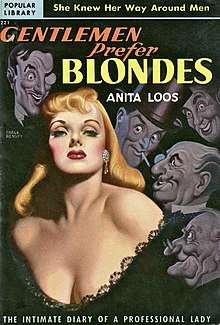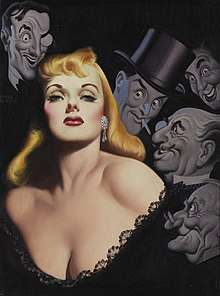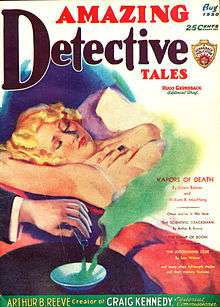Earle K. Bergey
Earle K. Bergey (August 26, 1901 – September 30, 1952) was an American artist and illustrator who painted cover art for thousands of pulp fiction magazines and paperback books. One of the most prolific pulp fiction artists of the 20th century, Bergey is recognized for creating the iconic cover of Gentlemen Prefer Blondes for Popular Library at the height of his career in 1948.



Bergey was born in Philadelphia, Pennsylvania to A. Frank and Ella Kulp Bergey. He attended Pennsylvania Academy of the Fine Arts from 1921 to 1926, finishing formal Academy studies in the spring of 1926. He initially went to work in the art departments of Philadelphia newspapers including Public Ledger, and he drew the comic strip Deb Days in 1927. Early in his career, Bergey contributed many covers to the pulp magazines of publisher Fiction House. By the mid-1930s, Bergey made a home and studio in Bucks County, Pennsylvania, and he married in 1935.
Pulp magazines
Throughout the 1930s, Bergey worked freelance for a number of publishing houses. His eye-catching paintings were predominantly featured as covers on a wide array of pulp magazines, including romance (Thrilling Love, Popular Love, Love Romances) as well as detective, adventure, aviation, and Westerns. Bergey illustrated mainstream publications, such as The Saturday Evening Post, during this time. He illustrated covers for fitness magazines. Along with pin-up painting peers such as Enoch Bolles and H.J. Ward, Earle K. Bergey was one of the first prominent American pin-up artists, contributing hundreds of covers to influential magazines including Gay Book Magazine, Pep Stories, and Snappy.
During the 1940s, Bergey continued to paint covers for romance, sports, and detective pulp magazines, and he began working on a number of science fiction magazines, including Standard Publications' Strange Stories, Startling Stories, and Captain Future, and later for Fantastic Story Magazine. Bergey's fine art training and salient gift for depicting anatomy made him a go-to artist across a diversity of genres that required scenes with dramatic movement, from photo-realistic sports portraits of famous athletes including Mickey Cochrane, Lou Gehrig, and Jim Thorpe to his signature Bergey Girls that appeared on risque pulps throughout the Depression and in science fiction scenarios from World War II.
The artist's illustrations of scantily-clad women surviving in outer space served as an inspiration for Princess Leia's slave-girl outfit in Return of the Jedi, even its color and cut, and Madonna's conical brass brassiere. Bergey's science fiction covers, sometimes described as "Bim, BEM, Bum," usually featured a woman being menaced by a Bug-Eyed Monster, alien, or robot, with an heroic male astronaut coming to her assistance. Bikini-tops worn by Bergey girls often resembled coppery metal, giving rise to the phrase "the girl in the brass bra," used in reference to this sort of art. Visionaries in TV and film have been influenced by Bergey's work; Gene Roddenberry, for example, provided his production designer for Star Trek with examples of Bergey's futuristic pulp covers.[2]
Paperbacks
In 1948, Bergey made the transition to the rapidly expanding paperback book industry along with skilled pulp artists like Rudolph Belarski, whose work is often confused with Bergey's. While continuing to paint pulp covers until his death, Bergey sold illustrations to at least four (4) leading paperback publishing houses, including Popular Library and Pocket Books. His art graced the covers of dozens of novels and helped to sell millions of volumes. His paperback cover illustrations were as diverse as his work for the pulps. In addition to his work on Anita Loos' famous Gentlemen Prefer Blondes, Bergey painted cover art for well-known authors from Émile Zola to the Western master, Zane Grey, whose 1951 Pocket Books edition cover painting for Spirit Of The Border is a Bergey classic. Many of his paperbacks are now cult classics, some featuring hidden self-portraits. Bergey died suddenly and unexpectedly on September 30, 1952 in New Hope, Pennsylvania with family at his side. Cause of death according to his State of Pennsylvania death certificate was acute coronary thrombosis due to coronary artery disease.
See also
- Good girl art
- List of pinup artists
- Paperback
- Pin-up girl
- Princess Leia's metal bikini
- Thrilling Publications
References
- "Publication: Amazing Detective Tales, August 1930". Internet Speculative Fiction Database
- Clark, Mark (2012). Star Trek FAQ: Everything Left to Know About the First Voyages of the Starship Enterprise. Applause: Milwaukee, WI.
- Bergey, Joshua David (2019). "[Pulp] Art is Not a Mirror: When the Male Gaze Determines the Defining Narrative of American Pulp Fiction Art." National Conference of the Popular Culture Association: Washington, DC.
- Bergey, Joshua David (2014). "Doubling in Murder: American Pulp Art and the Visual Legacy of Earle K. Bergey." Maine College of Art, Department of Illustration: Portland, ME.
- Di Fate, Vincent. Infinite Worlds: The Fantastic Visions of Science Fiction Art, with Foreword by Ray Bradbury. New York, NY: Penguin Studio, 1997. ISBN 0670872520.
- Lesser, Robert (1997). Pulp Art: Original Cover Paintings for the Great American Pulp Magazines. Gramercy Books. ISBN 0785817077..
- Lupoff, Richard A. (2001). The Great American Paperback: An Illustrated Tribute to Legends of the Book. Portland, OR: Collectors Press. ISBN 1888054506..
- Martignette, Charles G.; Louis K. Meisel (1996). The Great American Pin-up. Cologne: Taschen. ISBN 3-8228-1701-5.
- Scott, Alison M (1997). "They Came from the Newsstand." Primary Sources and Original Works. 4:1-2: 39–46. doi: 10.1300/J269v04n01_04.
- Strickler, Dave. Syndicated Comic Strips and Artists, 1924-1995: The Complete Index. Cambria, CA: Comics Access, 1995. ISBN 0-9700077-0-1.